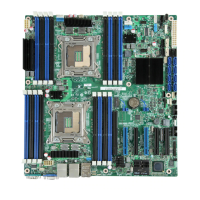Intel
®
Server Board S2600CP and Server System P4000CP TPS
Intel® Server Board S2600CP and Intel® Server System P4000CP Platform Management
Revision 1.1
Intel order number G26942-003
83
6.5.2.1 Force-enter BIOS Setup
KVM redirection can present an option to force-enter BIOS Setup. This enables the system to
enter F2 setup while booting which is often missed by the time the remote console redirects the
video.
6.5.3 Media Redirection
The embedded web server provides a Java applet to enable remote media redirection. This may
be used in conjunction with the remote KVM feature, or as a standalone applet.
The media redirection feature is intended to allow system administrators or users to mount a
remote IDE or USB CD-ROM, floppy drive, or a USB flash disk as a remote device to the server.
Once mounted, the remote device appears just like a local device to the server, allowing system
administrators or users to install software (including operating systems), copy files, update BIOS,
and so on, or boot the server from this device.
The following capabilities are supported:
The operation of remotely mounted devices is independent of the local devices on the
server. Both remote and local devices are useable in parallel.
Either IDE (CD-ROM, floppy) or USB devices can be mounted as a remote device to the
server.
It is possible to boot all supported operating systems from the remotely mounted device
and to boot from disk IMAGE (*.IMG) and CD-ROM or DVD-ROM ISO files. See the
Tested/supported Operating System List for more information.
Media redirection supports redirection for both a virtual CD device and a virtual
Floppy/USB device concurrently. The CD device may be either a local CD drive or else
an ISO image file; the Floppy/USB device may be either a local Floppy drive, a local
USB device, or else a disk image file.
The media redirection feature supports multiple encryption algorithms, including RC4
and AES. The actual algorithm that is used is negotiated with the client based on the
client’s capabilities.
A remote media session is maintained even when the server is powered-off (in standby
mode). No restart of the remote media session is required during a server reset or power
on/off. An BMC reset (for example, due to an BMC reset after BMC FW update) will
require the session to be re-established
The mounted device is visible to (and useable by) managed system’s OS and BIOS in
both pre-boot and post-boot states.
The mounted device shows up in the BIOS boot order and it is possible to change the
BIOS boot order to boot from this remote device.
It is possible to install an operating system on a bare metal server (no OS present) using
the remotely mounted device. This may also require the use of KVM-r to configure the
OS during install.
USB storage devices will appear as floppy disks over media redirection. This allows for the
installation of device drivers during OS installation.
If either a virtual IDE or virtual floppy device is remotely attached during system boot, both the
virtual IDE and virtual floppy are presented as bootable devices. It is not possible to present
only a single-mounted device type to the system BIOS.

